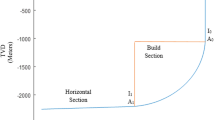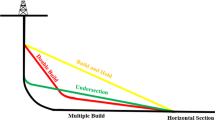The choice of location and orientation of the surface target-hitting point significantly affects the well productivity and wellbore stability of the reservoir. Thus, before starting actual drilling, the optimal location of the entering point and the direction of the well trajectory are determined by the numerical simulation method. However, the coordinates of the actual landing point and the direction vector of the trajectory are calculated assuming that the target-hitting surface of the reservoir is a plane. Compared with the curved target-hitting surface model, the planar model does not consider the actual shape of the reservoir surface, which can affect the accuracy of calculations. The inaccuracy of the simulation model can cause inaccurate landing and increase the operational costs of the drilling. In this paper, we propose a mathematical background for target-hitting trajectory design in the case of a nonplanar target-hitting surface. First, the elliptical truncated cone surface is assumed as the target-hitting surface due to its complex and diverse shape. Second, the vector algebra method is applied to develop a geometric model of the wellbore trajectory and elliptical truncated cone surface. Third, the target-hitting trajectory design model is established, and the model is solved by a genetic algorithm. Finally, a case study is performed. The off-target distance calculated by the horizontal circular target-hitting surface model is compared with the distance calculated by the horizontal elliptical target-hitting surface model and the proposed model. The case study indicates that the model established in this paper is more accurate than other models in the case of the elliptical truncated cone surface of the reservoir. The established model provides theoretical guidance for the target-hitting trajectory design for nonplanar surface reservoirs.






Similar content being viewed by others
References
I. Lanusse, F. Manuel, C. Pablo, C. Luisa, et al., "Multi-disciplinary approach for a landing point criteria in Vaca Muerta formation," SPE/AAPG/SEG Unconventional Resources Technology Conference, Austin, Texas, USA, July (2017).
N. Paulo, A. M. Vieira da Cunha, A. Gonçalves, et al., "Landing a well using deep-reading electromagnetic directional LWD - can we spare a pilot well?" Petrophysics, 54(2), 104-112 (2013).
P. Piyush, S. Priyavrat, Y. Ge, and Z. Xu, "Evaluating the impact of lateral landing, wellbore trajectory and hydraulic fractures to determine unconventional reservoir productivity," SPE/EAGE Conference and Exhibition, Copenhagen, Denmark, June (2018).
W. Wang, H. Wen, P. Jiang, et al., "Application of anisotropic wellbore stability model and unconventional fracture model for lateral landing and wellbore trajectory optimization: a case study of shale gas in Jingmen Area, China," IPTC - International Petroleum Technology Conference, Beijing, China, March (2019).
J. Wang and X. Jin, "Analysis of reservoir geological factors in horizontal well optimizing design," J. Xi'Shiyou Univ. (Nat. Sci. Ed), 12(5), 19-22 (1997).
Z. Han, "Design of horizontal well trajectory under the condition of two uncertainties," Acta Pet. Sin., 01,24-30 (1993).
X. Liu, "Universal methods for off-target distance calculation," Oil Drill. Prod. Technol., 01, 7-11(2008).
Z. Y. Han, "Calculation of off-target distance for direction wells," Pet. Drill. Technol., 05, 1-3 (2006).
Z. Y. Wang, Study on Optimal Design Theory & Method of Well Trajectory in Cluster Horizontal Wells for Shale Gas Development, China University of Petroleum, Beijing (2018).
C. Patrick and O. Mark, "Probabilistic seismic inversion using pseudo-wells," SEG Technical Programme Expanded Aspects, 627-631 (2017).
X. Liu and Z. Shi, "Improved method makes a soft landing of well path," Oil Gas J., 99, 47-51(2001).
L. U. Gang, C. Tong, and B. Xia, "Vector description of spatial-arc wellbore trajectory," Acta Pet. Sin., 35(4), 759-764 (2014).
H. L. Taylor and M. C. Mason, "A systematic approach to well surveying calculations," Soc. Pet. Eng. J, 12, 474488 (1972).
G. Wilson, "An improved method for computing directional surveys," J. Pet. Technol., 20, 871-876 (1968).
X. Liu, Y. Chu, and X. Wang, "Target situation analysis of directional wells and trajectory design of hitting targets," West-Chin. Explor. Eng., 05, 60-65 (1993).
J. Bai, "Arc model and its analytical solution for target hitting analysis of directional wells," Chin. Offshore Oil Gas, 19, 343-346 (2007).
ACKNOWLEDGMENTS
The authors gratefully acknowledge the financial support from the Natural Science Foundation of China (Grant numbers: 51821092 and U1762214). This research is also supported by other projects (Grant numbers: 2017Z105009-003, 2017ZX05005-005-007, 2018YFB0605502, 2016YFCO303303).
Author information
Authors and Affiliations
Corresponding author
Additional information
Translated from Khimiya i Tekhnologiya Topliv i Masel, No. 1, pp. 68-73, January — February, 2021.
THE COEFFICIENTS J-M IN EQ. (22)
THE COEFFICIENTS J-M IN EQ. (22)
The coefficients J-M in Eq. (22) can be calculated as
where j-t can be expressed as
Rights and permissions
About this article
Cite this article
Gu, Y., Gao, D. & Yang, J. A Design Model of Target-Hitting Trajectory Drilled Into the Reservoir with Elliptical Truncated Cone Surface. Chem Technol Fuels Oils 57, 107–119 (2021). https://doi.org/10.1007/s10553-021-01231-0
Published:
Issue Date:
DOI: https://doi.org/10.1007/s10553-021-01231-0




